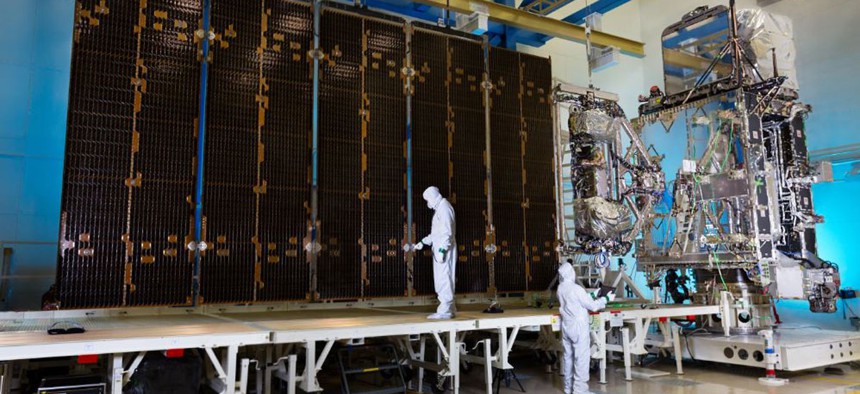Delays Plague NOAA’s $11B Satellite Program

The fully-integrated GOES-R satellite is shown in a clean room at a Lockheed Martin facility in Littleton, Colorado. NOAA
GOES-R has experienced developmental problems, inadequate contracting office support and other issues.
America’s next-generation geostationary weather satellite program is again at risk of postponing the launch date of its first satellite, which could leave weather forecasters on the ground without a backup satellite for nearly three years.
An audit released last week by the Commerce Department’s inspector general suggests the National Oceanic and Atmospheric Administration-led effort – called the Geostationary Operational Environmental Satellite-R series, or GOES-R – has experienced developmental problems, inadequate contracting office support and other issues.
GOES-R’s original launch date was October 2015. Last year, the launch date was moved to March 2016. The audit makes it clear that NOAA and its interagency partner, NASA, will have a difficult time meeting the new deadline.
“The delay could leave the GOES on-orbit constellation without a backup satellite for 29 months out of a 33-month period from April 2015 to January 2018,” the IG wrote.
The satellite’s price tag reflects the importance of the GOES constellation of satellites, two of which are fixed in orbit 22,300 miles above the eastern and western United States and one of which acts as an in-orbit backup, in adherence with NOAA policy. The satellites look for “atmospheric triggers” that cause hurricanes, tornadoes, flooding, blizzards and other extreme weather condition, in addition to providing an abundant amount of other vital data that makes up daily forecasts around the country.
Last year's launch delay decreased the probability of full geostationary satellite coverage when GOES-R is eventually ready for operations. Even if it is launched on time, the audit states there's still a risk that NOAA would be left without backup satellite coverage.
That's a bad omen considering that just over two years ago, a malfunction hampered the GOES-East satellite.
The audit found several contributing factors, including a lack of communication between stakeholders and inexperienced engineers hired for the project. NOAA agreed with all of the IG’s recommendations, which included a re-aligned development plan, streamlined testing and improved communications.



